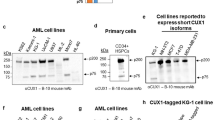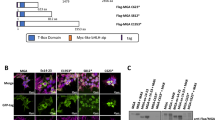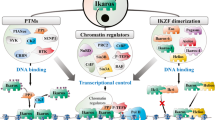Abstract
The DEK oncogene is highly expressed in cells from most human tissues and overexpressed in a large and growing number of cancers. It also fuses with the NUP214 gene to form the DEK-NUP214 fusion gene in a subset of acute myeloid leukemia. Originally characterized as a member of this translocation, DEK has since been implicated in epigenetic and transcriptional regulation, but its role in these processes is still elusive and intriguingly complex. Similarly multifaceted is its contribution to cellular transformation, affecting multiple cellular processes such as self-renewal, proliferation, differentiation, senescence and apoptosis. Recently, the roles of the DEK and DEK-NUP214 proteins have been elucidated by global analysis of DNA binding and gene expression, as well as multiple functional studies. This review outlines recent advances in the understanding of the basic functions of the DEK protein and its role in leukemogenesis.
This is a preview of subscription content, access via your institution
Access options
Subscribe to this journal
Receive 12 print issues and online access
$259.00 per year
only $21.58 per issue
Buy this article
- Purchase on Springer Link
- Instant access to full article PDF
Prices may be subject to local taxes which are calculated during checkout

Similar content being viewed by others
References
von Lindern M, Fornerod M, Soekarman N, van Baal S, Jaegle M, Hagemeijer A et al. Translocation t(6;9) in acute non-lymphocytic leukaemia results in the formation of a DEK-CAN fusion gene. Bailliere's Clin Haematol 1992; 5: 857–879.
Abba MC, Sun H, Hawkins KA, Drake JA, Hu Y, Nunez MI et al. Breast cancer molecular signatures as determined by SAGE: correlation with lymph node status. Mol Cancer Res 2007; 5: 881–890.
Carro MS, Spiga FM, Quarto M, Di Ninni V, Volorio S, Alcalay M et al. DEK expression is controlled by E2F and deregulated in diverse tumor types. Cell Cycle (Georgetown, TX) 2006; 5: 1202–1207.
Han S, Xuan Y, Liu S, Zhang M, Jin D, Jin R et al. Clinicopathological significance of DEK overexpression in serous ovarian tumors. Pathol Int 2009; 59: 443–447.
Kappes F, Khodadoust MS, Yu L, Kim DS, Fullen DR, Markovitz DM et al. DEK expression in melanocytic lesions. Hum Pathol 2011; 42: 932–938.
Kondoh N, Wakatsuki T, Ryo A, Hada A, Aihara T, Horiuchi S et al. Identification and characterization of genes associated with human hepatocellular carcinogenesis. Cancer Res 1999; 59: 4990–4996.
Kroes RA, Jastrow A, McLone MG, Yamamoto H, Colley P, Kersey DS et al. The identification of novel therapeutic targets for the treatment of malignant brain tumors. Cancer Lett 2000; 156: 191–198.
Orlic M, Spencer CE, Wang L, Gallie BL . Expression analysis of 6p22 genomic gain in retinoblastoma. Genes Chromosomes Cancer 2006; 45: 72–82.
Sanchez-Carbayo M, Socci ND, Lozano JJ, Li W, Charytonowicz E, Belbin TJ et al. Gene discovery in bladder cancer progression using cDNA microarrays. Am J Pathol 2003; 163: 505–516.
Casas S, Nagy B, Elonen E, Aventin A, Larramendy ML, Sierra J et al. Aberrant expression of HOXA9, DEK, CBL and CSF1R in acute myeloid leukemia. Leuk Lymphoma 2003; 44: 1935–1941.
Larramendy ML, Niini T, Elonen E, Nagy B, Ollila J, Vihinen M et al. Overexpression of translocation-associated fusion genes of FGFRI, MYC, NPMI, and DEK, but absence of the translocations in acute myeloid leukemia. A microarray analysis. Haematologica 2002; 87: 569–577.
Sanden C, Nilsson HJ, Gullberg U . The DEK oncoprotein is upregulated by multiple leukemia-associated fusion genes. Blood Cells Mol Dis 2014; 54: 284–285.
Logan GE, Mor-Vaknin N, Braunschweig T, Jost E, Schmidt PV, Markovitz DM et al. DEK oncogene expression during normal hematopoiesis and in Acute Myeloid Leukemia (AML). Blood Cells Mol Dis 2015; 54: 123–131.
Wise-Draper TM, Mintz-Cole RA, Morris TA, Simpson DS, Wikenheiser-Brokamp KA, Currier MA et al. Overexpression of the cellular DEK protein promotes epithelial transformation in vitro and in vivo. Cancer Res 2009; 69: 1792–1799.
Broxmeyer HE, Mor-Vaknin N, Kappes F, Legendre M, Saha AK, Ou X et al. Concise review: role of DEK in stem/progenitor cell biology. Stem Cells 2013; 31: 1447–1453.
Waldmann T, Scholten I, Kappes F, Hu HG, Knippers R . The DEK protein—an abundant and ubiquitous constituent of mammalian chromatin. Gene 2004; 343: 1–9.
von Lindern M, Fornerod M, van Baal S, Jaegle M, de Wit T, Buijs A et al. The translocation (6;9), associated with a specific subtype of acute myeloid leukemia, results in the fusion of two genes, dek and can, and the expression of a chimeric, leukemia-specific dek-can mRNA. Mol Cell Biol 1992; 12: 1687–1697.
Kappes F, Scholten I, Richter N, Gruss C, Waldmann T . Functional domains of the ubiquitous chromatin protein DEK. Mol Cell Biol 2004; 24: 6000–6010.
Aravind L, Koonin EV . SAP—a putative DNA-binding motif involved in chromosomal organization. Trends Biochem Sci 2000; 25: 112–114.
Waldmann T, Baack M, Richter N, Gruss C . Structure-specific binding of the proto-oncogene protein DEK to DNA. Nucleic acids Res 2003; 31: 7003–7010.
Alexiadis V, Waldmann T, Andersen J, Mann M, Knippers R, Gruss C . The protein encoded by the proto-oncogene DEK changes the topology of chromatin and reduces the efficiency of DNA replication in a chromatin-specific manner. Genes Dev 2000; 14: 1308–1312.
Waldmann T, Eckerich C, Baack M, Gruss C . The ubiquitous chromatin protein DEK alters the structure of DNA by introducing positive supercoils. J Biol Chem 2002; 277: 24988–24994.
Fu GK, Grosveld G, DEK Markovitz DM . DEK, an autoantigen involved in a chromosomal translocation in acute myelogenous leukemia, binds to the HIV-2 enhancer. Proc Natl Acad Sci USA 1997; 94: 1811–1815.
Adams BS, Cha HC, Cleary J, Haiying T, Wang H, Sitwala K et al. DEK binding to class II MHC Y-box sequences is gene- and allele-specific. Arthritis Res Ther 2003; 5: R226–R233.
Sanden C, Jarvstrat L, Lennartsson A, Brattas PL, Nilsson B, Gullberg U . The DEK oncoprotein binds to highly and ubiquitously expressed genes with a dual role in their transcriptional regulation. Mol Cancer 2014; 13: 215.
Hu HG, Scholten I, Gruss C, Knippers R . The distribution of the DEK protein in mammalian chromatin. Biochem Biophys Res Commun 2007; 358: 1008–1014.
Sawatsubashi S, Murata T, Lim J, Fujiki R, Ito S, Suzuki E et al. A histone chaperone, DEK, transcriptionally coactivates a nuclear receptor. Genes Dev 2010; 24: 159–170.
Takata H, Nishijima H, Ogura S, Sakaguchi T, Bubulya PA, Mochizuki T et al. Proteome analysis of human nuclear insoluble fractions. Genes Cells 2009; 14: 975–990.
Hu HG, Illges H, Gruss C, Knippers R . Distribution of the chromatin protein DEK distinguishes active and inactive CD21/CR2 gene in pre- and mature B lymphocytes. Int Immunol 2005; 17: 789–796.
Campillos M, Garcia MA, Valdivieso F, Vazquez J . Transcriptional activation by AP-2alpha is modulated by the oncogene DEK. Nucleic Acids Res 2003; 31: 1571–1575.
Koleva RI, Ficarro SB, Radomska HS, Carrasco-Alfonso MJ, Alberta JA, Webber JT et al. C/EBPalpha and DEK coordinately regulate myeloid differentiation. Blood 2012; 119: 4878–4888.
Shibata T, Kokubu A, Miyamoto M, Hosoda F, Gotoh M, Tsuta K et al. DEK oncoprotein regulates transcriptional modifiers and sustains tumor initiation activity in high-grade neuroendocrine carcinoma of the lung. Oncogene 2010; 29: 4671–4681.
Kappes F, Waldmann T, Mathew V, Yu J, Zhang L, Khodadoust MS et al. The DEK oncoprotein is a Su(var) that is essential to heterochromatin integrity. Genes Dev 2011; 25: 673–678.
Cavellan E, Asp P, Percipalle P, Farrants AK . The WSTF-SNF2h chromatin remodeling complex interacts with several nuclear proteins in transcription. J Biol Chem 2006; 281: 16264–16271.
Ko SI, Lee IS, Kim JY, Kim SM, Kim DW, Lee KS et al. Regulation of histone acetyltransferase activity of p300 and PCAF by proto-oncogene protein DEK. FEBS Lett 2006; 580: 3217–3222.
Kim DW, Chae JI, Kim JY, Pak JH, Koo DB, Bahk YY et al. Proteomic analysis of apoptosis related proteins regulated by proto-oncogene protein DEK. J Cell Biochem 2009; 106: 1048–1059.
Hollenbach AD, McPherson CJ, Mientjes EJ, Iyengar R, Grosveld G . Daxx and histone deacetylase II associate with chromatin through an interaction with core histones and the chromatin-associated protein Dek. J Cell Sci 2002; 115: 3319–3330.
Sammons M, Wan SS, Vogel NL, Mientjes EJ, Grosveld G, Ashburner BP . Negative regulation of the RelA/p65 transactivation function by the product of the DEK proto-oncogene. J Biol Chem 2006; 281: 26802–26812.
Privette Vinnedge LM, McClaine R, Wagh PK, Wikenheiser-Brokamp KA, Waltz SE, Wells SI . The human DEK oncogene stimulates beta-catenin signaling, invasion and mammosphere formation in breast cancer. Oncogene 2011; 30: 2741–2752.
Wise-Draper TM, Morreale RJ, Morris TA, Mintz-Cole RA, Hoskins EE, Balsitis SJ et al. DEK proto-oncogene expression interferes with the normal epithelial differentiation program. Am J Pathol 2009; 174: 71–81.
Ageberg M, Gullberg U, Lindmark A . The involvement of cellular proliferation status in the expression of the human proto-oncogene DEK. Haematologica 2006; 91: 268–269.
Broxmeyer HE, Kappes F, Mor-Vaknin N, Legendre M, Kinzfogl J, Cooper S et al. DEK regulates hematopoietic stem engraftment and progenitor cell proliferation. Stem Cells Dev 2012; 21: 1449–1454.
Wise-Draper TM, Allen HV, Thobe MN, Jones EE, Habash KB, Munger K et al. The human DEK proto-oncogene is a senescence inhibitor and an upregulated target of high-risk human papillomavirus E7. J Virol 2005; 79: 14309–14317.
Wise-Draper TM, Allen HV, Jones EE, Habash KB, Matsuo H, Wells SI . Apoptosis inhibition by the human DEK oncoprotein involves interference with p53 functions. Mol Cell Biol 2006; 26: 7506–7519.
Khodadoust MS, Verhaegen M, Kappes F, Riveiro-Falkenbach E, Cigudosa JC, Kim DS et al. Melanoma proliferation and chemoresistance controlled by the DEK oncogene. Cancer Res 2009; 69: 6405–6413.
Kappes F, Fahrer J, Khodadoust MS, Tabbert A, Strasser C, Mor-Vaknin N et al. DEK is a poly(ADP-ribose) acceptor in apoptosis and mediates resistance to genotoxic stress. Molecular and cellular biology 2008; 28: 3245–3257.
Kavanaugh GM, Wise-Draper TM, Morreale RJ, Morrison MA, Gole B, Schwemberger S et al. The human DEK oncogene regulates DNA damage response signaling and repair. Nucleic Acids Res 2011; 39: 7465–7476.
Meyn MS, Lu-Kuo JM, Herzing LB . Expression cloning of multiple human cDNAs that complement the phenotypic defects of ataxia-telangiectasia group D fibroblasts. Am J Hum Genet 1993; 53: 1206–1216.
Mor-Vaknin N, Punturieri A, Sitwala K, Faulkner N, Legendre M, Khodadoust MS et al. The DEK nuclear autoantigen is a secreted chemotactic factor. Mol Cell Biol 2006; 26: 9484–9496.
Saha AK, Kappes F, Mundade A, Deutzmann A, Rosmarin DM, Legendre M et al. Intercellular trafficking of the nuclear oncoprotein DEK. Proc Natl Acad Sci USA 2013; 110: 6847–6852.
Privette Vinnedge LM, Ho SM, Wikenheiser-Brokamp KA, Wells SI . The DEK oncogene is a target of steroid hormone receptor signaling in breast cancer. PLoS One 2012; 7: e46985.
Sitwala KV, Adams K, Markovitz DM . YY1 and NF-Y binding sites regulate the transcriptional activity of the dek and dek-can promoter. Oncogene 2002; 21: 8862–8870.
Kappes F, Damoc C, Knippers R, Przybylski M, Pinna LA, Gruss C . Phosphorylation by protein kinase CK2 changes the DNA binding properties of the human chromatin protein DEK. Molecular and cellular biology 2004; 24: 6011–6020.
Cleary J, Sitwala KV, Khodadoust MS, Kwok RP, Mor-Vaknin N, Cebrat M et al. p300/CBP-associated factor drives DEK into interchromatin granule clusters. J Biol Chem 2005; 280: 31760–31767.
Le Hir H, Izaurralde E, Maquat LE, Moore MJ . The spliceosome deposits multiple proteins 20-24 nucleotides upstream of mRNA exon–exon junctions. EMBO J 2000; 19: 6860–6869.
McGarvey T, Rosonina E, McCracken S, Li Q, Arnaout R, Mientjes E et al. The acute myeloid leukemia-associated protein, DEK, forms a splicing-dependent interaction with exon–product complexes. J Cell Biol 2000; 150: 309–320.
Soares LM, Zanier K, Mackereth C, Sattler M, Valcarcel J . Intron removal requires proofreading of U2AF/3' splice site recognition by DEK. Science (New York, NY) 2006; 312: 1961–1965.
Reichert VL, Le Hir H, Jurica MS, Moore MJ . 5' Exon interactions within the human spliceosome establish a framework for exon junction complex structure and assembly. Genes Dev 2002; 16: 2778–2791.
Gamble MJ, Fisher RP . SET and PARP1 remove DEK from chromatin to permit access by the transcription machinery. Nat Struct Mol Biol 2007; 14: 548–555.
Dong X, Wang J, Kabir FN, Shaw M, Reed AM, Stein L et al. Autoantibodies to DEK oncoprotein in human inflammatory disease. Arthritis Rheum 2000; 43: 85–93.
Sierakowska H, Williams KR, Szer IS, Szer W . The putative oncoprotein DEK, part of a chimera protein associated with acute myeloid leukaemia, is an autoantigen in juvenile rheumatoid arthritis. Clin Exp Immunol 1993; 94: 435–439.
Wichmann I, Respaldiza N, Garcia-Lozano JR, Montes M, Sanchez-Roman J, Nunez-Roldan A . Autoantibodies to DEK oncoprotein in systemic lupus erythematosus (SLE). Clin Exp Immunol 2000; 119: 530–532.
Schwartz S, Jiji R, Kerman S, Meekins J, Cohen MM . Translocation (6;9)(p23;q34) in acute nonlymphocytic leukemia. Cancer Genet Cytogenet 1983; 10: 133–138.
Vermaelen K, Michaux JL, Louwagie A, Van den Berghe H . Reciprocal translocation t(6;9)(p21;q33): a new characteristic chromosome anomaly in myeloid leukemias. Cancer Genet Cytogenet 1983; 10: 125–131.
Oyarzo MP, Lin P, Glassman A, Bueso-Ramos CE, Luthra R, Medeiros LJ . Acute myeloid leukemia with t(6;9)(p23;q34) is associated with dysplasia and a high frequency of flt3 gene mutations. Am J Clin Pathol 2004; 122: 348–358.
Slovak ML, Gundacker H, Bloomfield CD, Dewald G, Appelbaum FR, Larson RA et al. A retrospective study of 69 patients with t(6;9)(p23;q34) AML emphasizes the need for a prospective, multicenter initiative for rare 'poor prognosis' myeloid malignancies. Leukemia 2006; 20: 1295–1297.
Sandahl JD, Coenen EA, Forestier E, Harbott J, Johansson B, Kerndrup G et al. t(6;9)(p22;q34)/DEK-NUP214 rearranged pediatric myeloid leukemia: an international study on 62 patients. Haematologica 2014.
Fornerod M, Boer J, van Baal S, Jaegle M, von Lindern M, Murti KG et al. Relocation of the carboxyterminal part of CAN from the nuclear envelope to the nucleus as a result of leukemia-specific chromosome rearrangements. Oncogene 1995; 10: 1739–1748.
Ageberg M, Drott K, Olofsson T, Gullberg U, Lindmark A . Identification of a novel and myeloid specific role of the leukemia-associated fusion protein DEK-NUP214 leading to increased protein synthesis. Genes Chromosomes Cancer 2008; 47: 276–287.
Oancea C, Ruster B, Henschler R, Puccetti E, Ruthardt M . The t(6;9) associated DEK/CAN fusion protein targets a population of long-term repopulating hematopoietic stem cells for leukemogenic transformation. Leukemia 2010; 24: 1910–1919.
Boer J, Bonten-Surtel J, Grosveld G . Overexpression of the nucleoporin CAN/NUP214 induces growth arrest, nucleocytoplasmic transport defects, and apoptosis. Mol Cell Biol 1998; 18: 1236–1247.
Sanden C, Ageberg M, Petersson J, Lennartsson A, Gullberg U . Forced expression of the DEK-NUP214 fusion protein promotes proliferation dependent on upregulation of mTOR. BMC Cancer 2013; 13: 440.
Cancer Genome Atlas Research Network. Genomic and epigenomic landscapes of adult de novo acute myeloid leukemia. N Engl J Med 2013; 368: 2059–2074.
Thiede C, Steudel C, Mohr B, Schaich M, Schakel U, Platzbecker U et al. Analysis of FLT3-activating mutations in 979 patients with acute myelogenous leukemia: association with FAB subtypes and identification of subgroups with poor prognosis. Blood 2002; 99: 4326–4335.
Author information
Authors and Affiliations
Corresponding author
Ethics declarations
Competing interests
The authors declare no conflict of interest.
Rights and permissions
About this article
Cite this article
Sandén, C., Gullberg, U. The DEK oncoprotein and its emerging roles in gene regulation. Leukemia 29, 1632–1636 (2015). https://doi.org/10.1038/leu.2015.72
Received:
Revised:
Accepted:
Published:
Issue Date:
DOI: https://doi.org/10.1038/leu.2015.72
This article is cited by
-
Exosomal DEK removes chemoradiotherapy resistance by triggering quiescence exit of breast cancer stem cells
Oncogene (2022)
-
Unclassified Neuroendocrine Tumor with a Novel CHD4::AFF2 Fusion: Expanding the Family of AFF2-Rearranged Head and Neck Malignancies
Head and Neck Pathology (2022)
-
Transformation of human CD34+ hematopoietic progenitor cells with DEK-NUP214 induces AML in an immunocompromised mouse model
Oncogene (2016)



